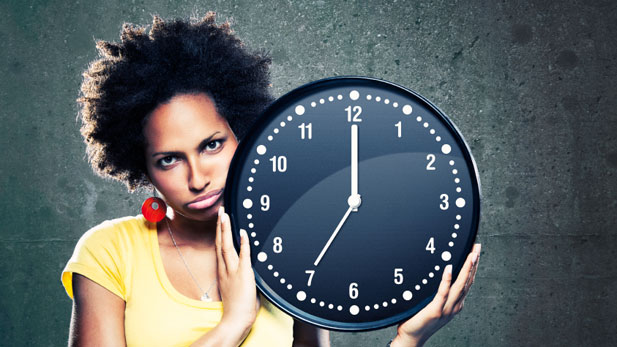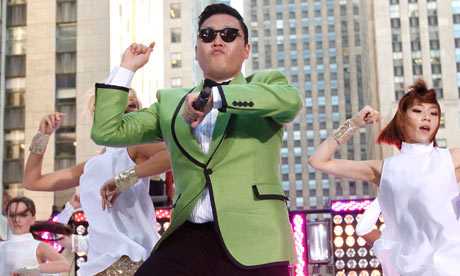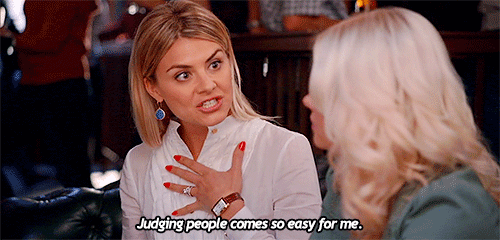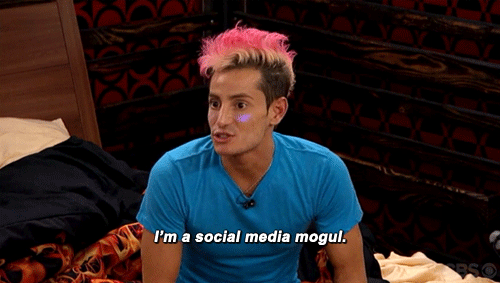February 22 to 28 is National Eating Disorders Awareness Week. We'll be sharing information about this important issue throughout the week, from what to do if you or a friend is suffering from an eating disorder to how to love your body just the way it is! Be sure to check out all of our content here.
![]()
“I cannot tell you how many collegiettes I know who will brag about how few calories they eat,” says Kelsey Mulvey, a junior at Boston University. “One friend told me she was sticking to a 700 a day calorie diet! If you're not meeting your nutritional needs, that's an issue!”
Kelsey is right—calorie counting is a method that many collegiettes use to diet and to maintain their current weights. Instead of simply eating without any knowledge or concern of the nutritional content of the food in front of her, a calorie counter will read labels and record her total caloric intake each day, limiting that intake to a specific number tailored to her weight loss or maintenance goal.
But while calorie counting can be a helpful tool in some respects, it can also be dangerous when taken too far. We need to consume a certain number of calories daily (for women this is generally a minimum of 1,200 but this depends on our age, size, and activity level) to carry out basic daily functions and simply survive. Cutting below this bare minimum can put physical and mental health at serious risk.
Since monitoring calories is such a common practice amongst collegiettes, we want to determine when, how, and why calorie counting stops being healthy and becomes extreme, obsessive, and destructive.
What is a Calorie?
![]()
As you may remember from your high school biology class, calories are a measurement of the amount of energy needed to complete daily functions like thinking, breathing, resting and playing. Calories are also measured in food as a way to access the energy content of that particular food.
Many collegiettes use calories as a way to measure the nutritional content of the foods they eat each day. Having knowledge of the benefits of different foods can help us to maintain or lose weight, or even to avoid overeating.
“Calories can be a useful tool,” says Registered Dietitian Heidi Pflugrath. “But it is important to understand that they are just that: a measurement tool, like inches or ounces.”
According to Pflugrath, a 20-year-old female who is moderately active (runs 30 minutes, 5 times each week), is 5’6” and weighs 140 pounds would probably need to consume about 1800 calories per day to stay at a fit, healthy weight (in addition to getting a full night of sleep each night, making sure her meals are well-rounded nutritionally and maintaining positive mental health). A woman who has a slightly smaller frame, is 5’4”, and who exercises similarly to the other woman would need to consume approximately 1600 calories. If she exercises more than 30 minutes per day, she would need to consume more calories.
In order to really understand these numbers, it is necessary to understand how weight loss works. To put it simply, there are 3,500 calories in one pound, so you need to burn 3,500 more calories than you consume in one week to lose one pound per week. This means you need a 500-calorie deficit daily. An example of a safe, healthy way to do this would be to cut out 250 calories and burn 250 during exercise every day. To find out how many calories you personally need to consume each day, check out this goal weight calculator on caloriecounter.com.
What Is Extreme Calorie Counting?
“The average adult requires roughly 1200 calories for basic daily functions if they are not exercising,” says Pflugrath. “These calories are necessary for basic thinking, basic movement, and for your body organs to properly work.”
But those 1200 calories are rarely enough to function properly if you are expending even a tiny amount of energy during the day, which is why cutting below this number is considered extreme and can cause a host of major health problems.
Deirdre is one of the many collegiettes who have struggled with extreme calorie counting. She says that limiting her calories obsessively ended up being a “gateway” into a plethora of other eating issues.
“It started as something small - eliminating 200 calories at dinner or avoiding snacks that were over 150 calories - and before I realized what was happening, it evolved into an obsession,” she explains. “I refused to eat more than 900 calories ever and eventually tried changing my calorie intake daily (with calorie intakes of 200, 350, 800, 75, 625, 175, 900 as a usual week). It consumed my mind and from there things only got worse. It led me down a path of eating disorders and to this day, I still struggle to eat things when I don't know how many calories they have.”
Kathleen, another collegiette who has faced different eating issues, says she didn’t even realize that she was headed into dangerous territory when she first started restricting her calories in high school.
“As a freshman in high school, I was told by a family member that if I just kept running like I had been, I could lose weight and it would probably be fine,” she says. “Mind you, I was 120 pounds and 5' 5". I was healthy. At this point, I really didn't even think about counting calories. I just knew, or I thought I knew, that I should stop eating all together. I also began to work out more. During my lunch at school I would run laps around the track instead of eat, and then I would go home and go running again. I became really good at hiding it from people and I was really starting to see a difference in the way I was looking, not realizing entirely that I was ultimately hurting myself. After I began to see results, it became a control issue. I found that I had a lack of control over everything around me and the only thing I could truly control was my weight and what I was putting into my body, and so that is when my calorie counting became more intense.”
![]()
While many college women use calories as a way to track the healthiness (and unhealthiness) of what they eat, calorie counting can become obsessive and over-the-top when you begin to consume less than 1200 calories each day, as Kathleen and Deirdre both experienced.
What Leads to Extreme Calorie Counting?
“Extreme calorie counting and being too stringent with eating is a struggle for many college women, and it is usually control- and body image-related,” says Pflugrath.
Individuals may be more likely to have anorexia or to begin obsessively calorie counting if they are involved in a job or sport that stresses body size (like ballet, modeling or gymnastics), if they try to be perfect all of the time, never feel good enough or worry a lot, if they are dealing with stressful life events (like a divorce, moving to a new town or losing a loved one), or if other people in their family have an eating disorder as well.
Kathleen remembers restricting her calories in high school because she felt that she had no other way to stay slim.
“In high school, I joined cross country, and then the track team,” Kathleen says. “Being a part of these teams helped me because I could not run as fast as I needed to on empty – I had to eat. As soon as the off-season came, though, I went straight to cutting food out again because I had no way of burning the calories that I wanted to burn. So, I started counting them, too. I thought it would help me maintain what I had worked so hard for while I was on those teams. I thought I was going to be more attractive to my boyfriend, who thought I was nearly perfect and had no clue about my struggle. I thought, worst of all, that I would gain approval from the family member that initially said I needed to lose the weight.”
Deirdre remembers cutting calories because she assumed that it was the easiest way to lose weight. “I assumed that lowering my caloric intake would ultimately make me feel better about myself because I knew I'd lose weight,” she says. “I've had always maintained an average weight but I think I just wanted to be 10 pounds lighter and assumed that cutting calories was the easiest way to do it.”
Why Is Extreme Calorie Counting Dangerous?
As Pflugrath mentioned, approximately 1200 calories per day are required for basic daily functions (if you aren’t exercising). And when you limit yourself to less than 1200 calories, you are putting yourself at risk both emotionally and physically. Without enough calories, you will find yourself feeling exhausted, depressed and with hardly enough energy to go about your daily tasks.
![]()
Deirdre describes the side effects of extreme calorie counting as nothing short of miserable.
“Imagine being so hungry that you can't sleep, or so hungry that you can't concentrate on anything but the next time you will eat,” she says. “I got mean too, especially to my family, I was always snapping over the smallest things. Headaches were another effect. From morning to night my head pounded in the worst way. Headaches also went hand in hand with being so dizzy that I always needed to hold onto a railing, or the wall, just in case I started to fall.”
Kathleen also struggled to hide the negative side effects of her obsessive calorie counting from her friends and family.
“Once I started counting calories so obsessively, I became more and more obsessive about everything else,” she says. “Not just weight loss, but image in general. I wanted to be better. I wanted to be the best. And, as far as anyone could tell—I was. I was first place in the majority of my track and cross-country races, I took beautiful pictures, and I had a smile bigger than anyone could have ever thought possible. But, it was all an act - and this is where my physical problems began to really present themselves. I nearly passed out after my races because I was so hungry. I was wearing so much makeup to cover the bags under my eyes in all of my pictures, and I wore clothing that looked bigger so that people wouldn't begin to question me.”
![]()
Pflugrath isn’t surprised by Kathleen and Deirdre’s comments. In fact, their symptoms are common for individuals who try to remain on very low calorie diets or who suffer from anorexia.
“When someone does not receive proper nutrition each day, which means fats, carbohydrates and proteins, then they are at risk for many side effects,” she says. “The body will dip into starvation mode which acts to preserve fat and essential nutrients.”
Without the proper amount of calories, you may experience an irregular heartbeat because there is not enough fat around the heart to protect it and hold it in the right body cavity. You may also experience ketosis, or the use of fat for energy, which in turn causes ketone formation, which can be harmful to the body as well. And as you restrict your calories, you may experience constipation, nausea, gallstones and diarrhea from the lack of nutrients in your body. Without vitamins, you will find that your hair will grow slower, your fingernails may become brittle and your skin may begin to feel oddly dry. Without nutrients and energy, the body cannot function in its normal, healthy state.
Extreme calorie counting can also slow the body’s metabolism because there are fewer calories to process. For this reason, when you begin consuming a normal number of calories again, your body will not be able to process it as quickly and you may gain weight more rapidly than before. So while severely cutting calories may seem like the best way to lose weight because of how quickly the pounds initially come off, it is not sustainable, nor effective, in the long run.
In addition to the physical and emotional side effects, extreme calorie counting also has dangerous mental consequences.
“Restricting your diet can cause a lack of glucose which is needed for ideal brain function,” says Pflugrath.
This lack of glucose can lead to impaired judgment, irrational behavior, obsessive compulsive disorder, panic attacks and irrational fears. Many extreme calorie counters also experience body dysmorphic disorder, a disorder in which the individual sees something in the mirror that does not exist – usually a woman whom they perceive to be overweight and in need of further dieting. Depression can also occur because of a restricted diet.
As if all these side effects were not alarming enough, another concern of extreme calorie counting is the way that it can quickly develop into a full-fledged eating disorder, such as anorexia.
“Anorexia nervosa affects many college-aged females and almost always begins with a strict diet plan one is forcing themselves to follow,” says Pflugrath. “Limiting foods then leads to unhealthy weight loss and malnutrition, in addition to triggering other negative health issues. People who have anorexia have an intense fear of gaining weight. They severely limit the amount of food they eat and can become dangerously thin.”
What Can You Do?
![]()
“It is very important that we realize the harsh side effects and physical risks associated with very low calorie diets,” says Pflugrath. “They can turn into serious, life-threatening diseases. If you or someone you know seems to be suffering from some of the issues mentioned, or if you feel like you lack control over your food and body image behaviors, please seek professional help. Most colleges have a counseling center that offers confidential services to help you gain a healthy relationship with food and eating.”
Deirdre seconds Pflugrath’s advice and urges everyone to talk to a nutritionist if they want to lose weight in a healthy way. “Calories are not the enemy,” she says. “We are human beings that rely on them to survive. I know that now. There are healthier ways to lose weight than forcing your body to run on negative energy!”
Kathleen agrees and says that she still struggles with calorie counting today. She hopes that her story will help other collegietes to stop restricting their diets before they get into dangerous territory. “It becomes a disease. If you want to better your health, don't drop caloric intake. Understand the value of everything you put into your body and know that you can eat and exercise in a healthy way and still see results that are healthy,” she says.
If you have a friend who is struggling with severe calorie counting, or if you are struggling with limiting your diet obsessively, seek help! Whether it’s talking to a friend, a professional counselor or a nutritionist, you will be able to gain the tools to live a healthier life.
Pflugrath believes that calorie counting can be used (in a good way!) as a tool to help with weight loss, but only if the calorie counting is a part of a larger plan for wellness. “I think that it is healthy to look at nutrition holistically, meaning looking at your state of wellness inclusive of mental health, nutrition, physical activity and rest, rather than merely calorie counting and not exercising, or just exercising and not eating properly,” she says.
Instead of focusing only on calories, Pflugrath believes that women should consciously work to live healthy lifestyles. Losing weight by eating healthily (and focusing on the nutritional content, rather than the calorie number, on the package) and staying active, are much healthier ways to feel more positive about the way you look. She especially suggests choosing whole grains, incorporating fruits and veggies into your diet, consuming lean protein sources, eating certain vegetable fats (like avocados and olive oil), staying hydrated, sleeping well, incorporating 30 minutes of physical activity into your daily routine and figuring out what you need to do to de-stress at the end of the day—whether it’s reading, running, stretching, painting your nails or listening to music!
The Bottom Line
The life of a college student is full of pressures—the pressure to choose a career path, to make friends, to fit in, to be stylish, to live on your own successfully, to work, to earn money to live off of and, in the midst of all of that, to pass your difficult classes with flying colors. Let’s face it—it’s stressful! And with all of this surrounding us, college women often look for something to control in their lives. More often than not, that thing turns out to be food. So if you find yourself obsessively counting your calories at every meal, take a step back and talk to someone about it. You could be in danger, and there are healthy choices that you can make to lose weight in a more well-rounded, positive way.
Think you might be suffering from an eating disorder? The National Eating Disorders Association has a free and confidential screening to help you determine next steps. If you're looking for more information, be sure to call the NEDA helpline. Looking for ways to help spread the word? Find out how you can get involved on your campus.
















































































































































